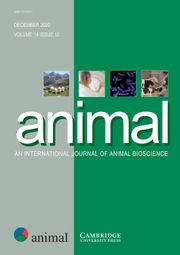Article contents
Genomic selection for feed efficiency in dairy cattle
Published online by Cambridge University Press: 16 October 2013
Abstract
Feed is a major component of variable costs associated with dairy systems and is therefore an important consideration for breeding objectives. As a result, measures of feed efficiency are becoming popular traits for genetic analyses. Already, several countries account for feed efficiency in their breeding objectives by approximating the amount of energy required for milk production, maintenance, etc. However, variation in actual feed intake is currently not captured in dairy selection objectives, although this could be possible by evaluating traits such as residual feed intake (RFI), defined as the difference between actual and predicted feed (or energy) intake. As feed intake is expensive to accurately measure on large numbers of cows, phenotypes derived from it are obvious candidates for genomic selection provided that: (1) the trait is heritable; (2) the reliability of genomic predictions are acceptable to those using the breeding values; and (3) if breeding values are estimated for heifers, rather than cows then the heifer and cow traits need to be correlated. The accuracy of genomic prediction of dry matter intake (DMI) and RFI has been estimated to be around 0.4 in beef and dairy cattle studies. There are opportunities to increase the accuracy of prediction, for example, pooling data from three research herds (in Australia and Europe) has been shown to increase the accuracy of genomic prediction of DMI from 0.33 within country to 0.35 using a three-country reference population. Before including RFI as a selection objective, genetic correlations with other traits need to be estimated. Weak unfavourable genetic correlations between RFI and fertility have been published. This could be because RFI is mathematically similar to the calculation of energy balance and failure to account for mobilisation of body reserves correctly may result in selection for a trait that is similar to selecting for reduced (or negative) energy balance. So, if RFI is to become a selection objective, then including it in an overall multi-trait selection index where the breeding objective is net profit is sensible, as this would allow genetic correlations with other traits to be properly accounted for. If genetic parameters are accurately estimated then RFI is a logical breeding objective. If there is uncertainty in these, then DMI may be preferable.
Information
- Type
- Full Paper
- Information
- Copyright
- Copyright © The Animal Consortium 2013
References
- 78
- Cited by

